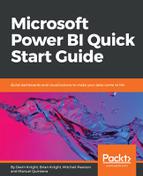Also located under the View ribbon, we will find the Selection pane directly underneath the Bookmarks pane, and all we need to do is place a check mark inside the box. Immediately, you will see that another window will appear directly next to the Bookmarks pane. This pane provides a list of all the objects on the current page, and allows the user to decided whether a specific visual will be visible or not. This will allow us to efficiently use the space given to us within the report page. To demonstrate this, go ahead and make a duplicate of the Stacked Column Chart we currently have in the Summary Page. With this duplicate visual selected, let's change it to a Table visual and move it so that it lies directly on top of the column chart. Initially, it will look a little chaotic. You will see that this new visual is showing up in the Selection pane at the very bottom. In my example, it is called Table. Just to the right of this object, inside of the Selection pane, you will see an eye icon. By selecting this icon, you will see that the table visual disappears—it is still part of the report page, but has been hidden. Let's add a new bookmark and call it Column View. Also, for this new Column View bookmark, let's ensure that the Data option is not selected, as shown in Figure 6.6:

Let's create just one more bookmark, where we show the Table visual and instead hide the Stacked Column Chart visual. We will call this bookmark Table View, and it should also have the Data option deselected. We can now see that we have two different ways of displaying the same data within the same report page, really making the most of the space we have available. Also, there is another method that we can use to provide our users the ability to select between these two bookmarks using images, which is very exciting! Under the Home ribbon, you will find an option that says Image. This will launch a file browser to select an image file. For our example, navigate to C:PacktMisc and you will see two images: one that shows Column highlighted and the other showing Table. Bring both of these visuals into the Summary Page and, to the best of your ability, stack them on top of each other. To more easily distinguish the two images within the Selection pane, choose the image that has Table highlighted and turn on the Title option from the Format Image area, as shown in Figure 6.7. You will see in Figure 6.7 that, after naming the object Table Image, the Title option was turned off, but now we can easily distinguish between the two images:

Now we can make it so that when our users click on this image, it will take us to the designated bookmark. So, for our example, we need to make a couple of quick updates to the Column View and Table View bookmarks. Let's begin by selecting the Column View bookmark and then hiding the object from the Selection pane labeled Table Image. Once this has been done, you can select the ellipsis for the Column View bookmark and choose the Update option. We now need to make the same change for the Table View bookmark by hiding the Stacked Column Chart visual and the Image object while making the Table and the Table Image object visible. Don't forget to choose the Update option once you have made the listed changes. The last piece that will tie all of this together is to assign an Action to the appropriate image within our bookmarks. While we still have the Table View bookmark selected, highlight the Table Image object and you will see an option within the Format Image area called Action. By expanding this Action area, you will see that we can change the Type selection, choose the Bookmark option, and then specify which bookmark the image will point to. The correct option in this situation would be choosing the Column View bookmark, as shown in Figure 6.8:

We have now made it so that when a user clicks on the Table Image object, we will be taken to the Column View bookmark. This makes our static image feel like an interactive button. In order to experience this behavior while developing the report, just hold the Ctrl key on the keyboard and left-click the image, and you will be taken to the Column View bookmark. To finish off this example, let's make the same changes to the Column View bookmark and set the Image object to have an Action that will point back to the Table View bookmark. Now we have set the behavior so that our users can freely choose how they will look at the data while making the most of the space within the report page. Hopefully, with these examples you can start to see the depth of what can be achieved by using the Selection pane and Bookmarks pane features for your digital storytelling.
